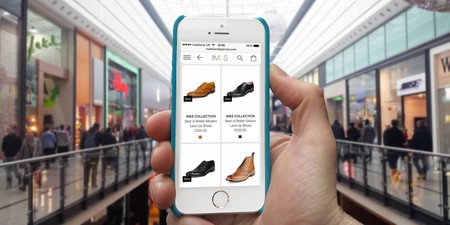Fascinating insights: E-commerce expo day 1
This week we attended the London e-commerce expo to discover the latest statistics, technology and importantly, what’s predicted to be big in 2015. Here’s our write-up of the sessions we attended on day 1 (day 2 to come soon). What’s very clear is that mobile will be massive in 2015! New technology enabling more advanced tracking of customers offline and online will also pave the way for advanced data, customer engagement and retargeting across channels (more of this in our next blog post: day 2).
Driving Sales in a connected world
Tracy Yaverbaun, Facebook

Mobile was a key theme in Tracy’s presentation. There has been a huge change in devices and multi-device use, for marketers this is a huge challenge!
Mobile is where the growth is and where it will continue to be but brands aren’t moving as fast as consumers.
Only 4% of budgets go into mobile but it’s where 20% of consumers time is. Everything has to work on mobile for facebook now.
80% of Facebook’s users are mobile. 26m daily users on facebook, out of these 23m are mobile .
Mobile is disrupting commerce. Physical shop real estate is shrinking so e-commerce is more important than ever. Yet the screen size is smaller so marketers have to work harder on the small screen real estate.
Consumers want msgs relevant to them at the right place at the right time. You need to consider:
1. Discovery. People can find your brand. The Facebook newsfeed is one of the best places for consumers to discover products. Most people check their newsfeed a whopping 14 times every day!
2. Personalisation. Personalisation at scale. E.g. Amazon used Facebook to only target people who didn’t own kindles and were frequent flyers (using their CRM to filter out people who had kindles). It’s all about ‘good targeting’.
3. Measurement. ROI no matter which device consumers start or end their journey. Mobile has a huge amount of traffic but a lot of brands discount this. Marketers are obsessed with looking at clicks but they don’t matter, what matters is return on investment. Even if people don’t click, they’ve seen your message and taken in your brand. Facebook now has cross device measurement capability.
The future of ecommerce is personalised discovery across devices and that you can measure every step along the way.
The future of mobile on the high street
Andrew McClelland and Matt Norbury
What was very clear in this keynote, was that mobile is a huge, growing market and the key takeaway was that if you’re not focussed on mobile you are already getting left behind. Here are some of the key points:
Mobile growth is larger than tablet. 186% average growth in sales via mobile compared to 131% in tablet e-cmmerce. Average mobile conversion last year was 1.1%, this year 1.4%.
Basket size on mobiles is almost equal to desktop. £76 average basket value for mobile, average for desktop is £80.
8 in 10 smartphone users will use their smartphone at some point during the purchase process.
Mobile is critical to retail in the coming years. You have got to give people a real reason to engage – games and fun stuff. Add sufficient value that people keep coming back.
Don’t fear ‘showrooming’. Although people are using their mobiles inshore, most are actually just checking their email and social networks, not comparing prices.
Provide wifi. Wifi in-store is becoming a requisite – people expect it. Some people will leave a store if it doesn’t have wifi. Good for the guys whilst the girlfriend is shopping – keeps the boyfriend happier, keeps the girlfriend in the store for longer, everyones happy and the girlfriend has spent more.
Personalisation is big. 70% of people will give personal information and preferences to get something valuable in return such as offers.
Use beacons to measure footfall. Can measure uplift of message and conversion from a voucher you sent them. See the full end-to-end conversion, starting online, ending offline.
Five tips to make sure that customers transact with your app
David Pope, Jumio
25% of downloaded apps are NEVER used.
Nearly 66% of consumers making purchases on a tablet or phone, regularly abandon their purchases during the payment process.
David explained his top five tips to get customers using and buying from your mobile app:
1. Be aware which operating system or platform will deliver the best return for your app. Interestingly, although Google Plays market share is way more than Apple’s, Apple’s users actually spend more – almost five times as much! ios users display 6 times the engagement of android users and tablets drive about 20% more spending on avg. Avg spending is 89 eur for tablets, 67 for pcs, 66 for smartphones. Although this isn’t the same in every industry and he specifically excluded travel and gaming as not applicable.
2. Be sensitive to data privacy concerns that may inhibit app usage. Trust is the number barrier to growth of mobile content and commerce. 99% of users will not share their contact information. Less is more. Don’t ask for location, don’t ask how old the user is, don’t ask to access their contacts – greed for data gets in the way of transactions.
3. Reduce payment friction. This is all about your User Experience. David specifically talked about the keystroke level model – timing how long it will take customer to type data into your forms and working to reduce this number. And the gestalt laws of grouping (this is a more general design rule). Quite rightly, he pointed out that lots of apps still show alphanumeric keyboards for numeric data input – this is really frustrating and time consuming for your users. He also spoke of form length as important for reducing friction and gave the example of one change reduced to just 4 fields that resulted in 160% increase in conversions.
4. Balance functionality with speed and performance. There is a direct link between the performance of an app, number of downloads and its rankings in the app store. Tagman widget for calculating performance optimisation for your app. David recommends taking an MVP approach.
5. Build customer retention into your app. Integrate social features e.g. Sephora. Create a sense of community and use timely reminders, e.g. Map my run. Promote the benefits of your app, e.g. Swiftkey, tells you how much time you saved compare to normal keyboard. Personalise your customers experience.
Jumio
David’s aim in describing the above, was in promoting his product, Jumio. Basically instead of typing in their details, your customer would use Jumio on their mobile to scan their credit card and all the fields on your form would be populated automatically (Fastfill). Apparently this aids validation and reduces fraud. Note, legally, the customer still needs to manually enter their CVC number. It’s claimed that the average increase in form completion rate is 18-33%, coupled with less data entry errors.
Watch the video:
The customer journey report 2014
Dave Chaffey, Smart Insights
Dave’s slides can be viewed below. He placed focus on the customer journey and how wide it actually is – you need to focus on all channels, both online and offline and how people interact with / switch between them. It’s also important to use the right language for each of your personas to appeal to them in the words they use.
It was fairly disappointing to see that only 33% of respondents in the survey make use of usability studies but I’d be willing to bet that these 33% are the more successful companies. Clearly, there are a lot of companies that need to make greater use of user research methods as opposed to just analysing numbers.
Beware of the box: Don’t let your commerce software dictate how your business works
David Winterbottom
David’s presentation was from a more technical viewpoint, being from a developer background originally. I loved his approach to writing software requirements which is called YAGNI (You ain’t gonna need it). We often experience feature / scope creep in our UX world and we’re always battling against it, so YAGNI is definitely an acronym I’m going to be using! Quite rightly, David also advised that companies shouldn’t write a long list of software requirements at the RFP phase as this should be open at this stage to allow the company you work with to come up with the best solution, otherwise you’re already limiting them and telling them the solution.
I also liked the example that in Korea, customers can now scan QR codes to purchase things in the store. Soon, you’ll also be able to have your items delivered so that they’re waiting for you when you get back home (very cool).
David spoke briefly about an open source platform they’ve created called ‘Oscar‘. It’s totally free, designer friendly (apparently), and mobile by default. It’s built in Django and quick for prototyping which David said can be done in just a few days.
Read part 2 : More fascinating e-commerce insights for 2015!
Share this post:

